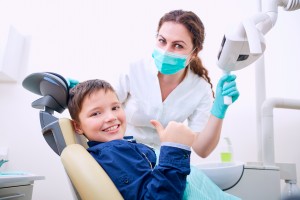 The American Academy of Pediatric Dentistry, in their “The State of Little Teeth” report, outline the many dangers of tooth decay for young children and the importance of early dental care the what they call “the Dental Home,” which comprises a strong relationship between the young patient and their dentist and a network of dental health care professionals. This includes preventative care and education, with strong dental hygiene practices that are maintained at home, school and elsewhere. But how can busy parents teach their child about healthy dental hygiene?
The American Academy of Pediatric Dentistry, in their “The State of Little Teeth” report, outline the many dangers of tooth decay for young children and the importance of early dental care the what they call “the Dental Home,” which comprises a strong relationship between the young patient and their dentist and a network of dental health care professionals. This includes preventative care and education, with strong dental hygiene practices that are maintained at home, school and elsewhere. But how can busy parents teach their child about healthy dental hygiene?
Setting a Good Example
Parents teach by example. Do you brush after meals? Are you too busy? Do you eat a healthy diet that supports your teeth and gums, and do you rinse your mouth or brush after eating sticky foods or sweets? Kids are very observant, and they will pick up on your good (and bad) habits.
Teaching Kids Good Dental Habits – Start Them Early!
According to WebMD, smart dental hygiene habits begin at birth, even before your baby has teeth! Parents and caretakers are encouraged to gently clean their baby’s gums with a baby toothbrush or soft washcloth and water. As soon as the first teeth appear, you should brush their teeth twice a day using a specially designed infant toothbrush and a very small amount of fluoridated toothpaste (just a tiny smear).
Good Dental Hygiene Habits for Children
Those little baby teeth should be starting to come in before the child’s first birthday. Around that time, you should be introducing your kids to the idea of putting a toothbrush in their mouth by gently cleaning their teeth with a baby’s toothbrush. As they get older, you can brush their teeth with an age-appropriate brush and toothpaste in front of a mirror while showing them how to do it. WebMD has a video that demonstrates how to teach tooth brushing to toddlers. Yes, it’s possible! Getting active young children interested in brushing their teeth involves getting them used to a twice-a-day habit and above all, making the activity fun. Here are some tips that can help.
- Let them pick out their own toothbrush. There are many children’s toothbrushes that feature favorite cartoon, TV, movie and video game characters in vibrant colors. With their favorite character, they’ll be more excited about brushing their teeth.
- Use age-appropriate toothpaste for children — in a flavor they enjoy. Kids’ toothpaste comes in fun flavors like strawberry. If you have a concern about your child swallowing toothpaste, fluoride-free children’s toothpaste is made with natural ingredients and is safer to swallow.
- Demonstrate flossing before bedtime. As soon as your child has two teeth next to each other, gently floss them. If you do it in front of a mirror, they’ll be able to see how it’s done.
- Introduce mouthwash when it’s appropriate. Ask their dentist when they should begin, and find a flavor they like. Make sure they know to spit it out!
- Get kids started on a healthy diet. A balanced diet helps to protect young teeth and gums. Limit sweets and sodas and teach them to brush after sweet or sticky foods. Encourage them to drink water rather than juice, which can contain added sugar that may lead to tooth decay.
- Let them get to know their dentist early. Children should see a dentist before their first birthday. Developing a relationship between the young patient and their dentist will help them feel more comfortable going for an exam and regular cleaning.
Resources for Teaching Children Healthy Dental Hygiene
The American Dental Association, on their Mouth Healthy™ Kids website, publishes activity sheets, games, videos and other resources to encourage children to practice healthy dental habits. These are great resources for parents, caretakers and teachers.







Leave a Reply